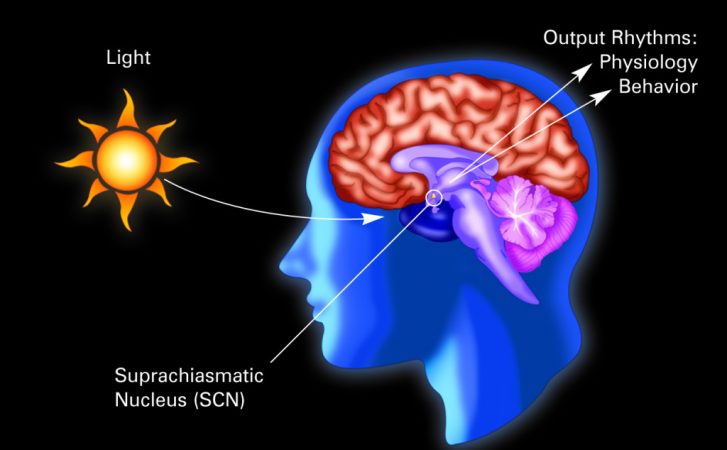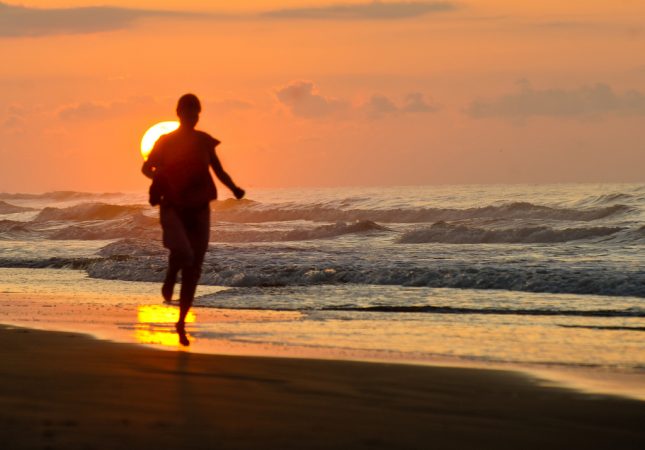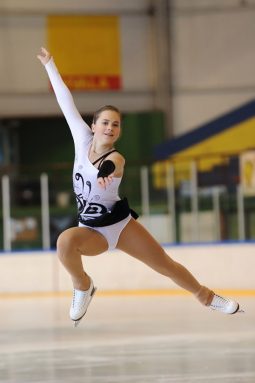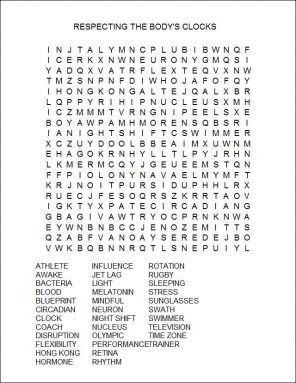Respecting the body’s clocks
Daily rhythms affect everything from the time we wake to how well we perform in sports

Circadian rhythms are biological cycles that occur about once every 24 hours. Driven by an internal “clock,” these include waking and falling asleep.
iStockphoto
Share this:
- Share via email (Opens in new window) Email
- Click to share on Facebook (Opens in new window) Facebook
- Click to share on X (Opens in new window) X
- Click to share on Pinterest (Opens in new window) Pinterest
- Click to share on Reddit (Opens in new window) Reddit
- Share to Google Classroom (Opens in new window) Google Classroom
- Click to print (Opens in new window) Print
Olympic athletes spend much of their lives preparing for a shot at a medal. Whether they take home a gold or no medal at all comes down to tiny differences in speed and precision. Many factors affect performance, from genetics and training to diet and confidence. Lately, athletes, coaches and researchers have begun taking a close look at another factor — time of day. When athletes compete can also influence performance, scientists are finding.
People are precisely tuned to eat, sleep and wake at specific times. These predictable patterns are known as circadian rhythms. (In Latin, circa means “around,” and dian relates to “day.”)
Circadian rhythms are biological cycles that occur about once every 24 hours. Driven by an internal “clock,” these include waking and falling asleep. But outside factors can influence the cycles too. Among such factors: diet, stress and exposure to light.
Rhythms set by the body’s internal clock naturally ebb and flow. For example, body temperature is lowest around 4 a.m. and highest around 7 p.m. Interestingly, more world records have been broken in the evening than in the morning. And research has shown that many athletes perform best in the afternoon or evening — near the peak of body temperature. But it’s not clear why: Are circadian rhythms responsible? Or are other factors at play?
Shawn Youngstedt decided to probe these evening performance peaks by athletes. He works at the University of South Carolina in Columbia. As a chronobiologist, Youngstedt studies circadian rhythms.
He and one of his students tested 25 highly trained college swimmers, giving them an unusual schedule. For two hours, each athlete was exposed to dim light but instructed to stay awake. Then all lights were turned off and each swimmer was told to try sleeping for an hour. This pattern was repeated over and over for more than two days.
All also swam 200-meter sprints (four lengths of an Olympic-size pool) at six different times over the test period. Some sprints occurred in the middle of the night.
Swimmers recorded their best times in the evening. They finished, on average, about 6 seconds faster between 8 and 11 p.m. than they had during their best morning sprints.
In sports, six seconds is huge. “If that really transfers at all to a real world situation, that’s more time than separates first from eighth place in 200-meter freestyle at the Olympics,” notes Youngstedt.
During this trial, diet and exposure to light were kept exactly the same for each participant. So the findings suggest that circadian rhythms accounted for the better speeds at night. An evening peak might be due to a combination of higher heart rate — beats per minute — and better flexibility of blood vessels, researchers say. Both improve blood flow. And more blood flow moves more oxygen to fuel muscles.
Increasingly, elite athletes and their trainers are consulting with scientists on circadian rhythms. These experts can help athletes adjust more quickly to changes in time zones as they travel for competitions. New research also is revealing the complexity of the body’s internal clock, and how much can go wrong when the cycles it controls fall out of sync.
The oldest clock
The body’s clocklike rhythms regulate every biological process. And they do this in every life form, from bacteria to people. Take morning glories. These flowers open and close their petals at specific times every day. Driving this is the same type of circadian system found in people.
The circadian system “is probably one of the most ancient biological systems you can imagine,” says Paolo Sassone-Corsi. In fact, he adds, it’s probably been at play as long as there has been life on Earth.

Sassone-Corsi works at the University of California, Irvine. There he studies how circadian rhythms are linked to the chemical reactions that maintain life in every cell. Collectively, these reactions are known as the body’s metabolism. Those reactions vary a lot over the course of 24 hours, but their schedule on any given day is little different than on any other. This shows, he says, that “basically every single step of our everyday life is controlled by the clock.”
He’s fascinated that rhythms the body clock regulates are tied so closely to the length of Earth’s rotation. Life has not evolved — or adapted over time — to Earth’s 24-hour light/dark cycle, he says. Rather, life has evolved the way it has because of Earth’s 24-hour rotation. “We would be completely different if we had a different light/dark cycle,” he argues. “We wouldn’t even look the same.”
Inside every living thing is a pacemaker — or master clock. In people, this clock resides in the middle of the brain. It is called the suprachiasmatic nucleus (SU prah ki as MAT ik NU klee us). But don’t let the clock’s oversize name fool you. This timepiece is only about as big as a grain of rice. Still, it coordinates all of the body’s daily rhythms.
On its own, it doesn’t keep very accurate time. In some people and other life forms this clock may run a little fast. In others, a bit slow. So this pacemaker must be regularly reset. In people and many living things, the sun does this.
“Every day when you wake up, the sunlight resets you,” says Sarah Forbes-Robertson. She’s a molecular biologist who studies circadian rhythms at Swansea University in Wales. If we were stuck in a cave, without the sun to reset our clocks, says Forbes-Robertson, “we’d eventually end up completely out of sync.” We might wake in the dead of night and sleep all day.
Light cues reach the body’s master clock through very specialized cells in the retina. This light-sensitive layer of tissue lines the back of our eyes. When light hits its cells, they dispatch chemicals to the brain’s master clock. There, they trigger about 20,000 neurons, or nerve cells, which “talk” to the rest of the body.
Those neurons tell the body when to release hormones. Hormones relay chemical instructions to distant parts of the body. These chemical messengers turn on activities at precise times and in specific cells. They say, for example: It’s time to eat. Or, it’s time to wake up. Or, it’s time to be really alert.
More than one clock
Scientists once thought that the brain’s central clock was the body’s only one — that it alone directed every tissue in the body. But in the past 15 years, researchers have found the real story is much more complex.
“We’re finding that each little cell [in the body] has its own clock,” explains Forbes-Robertson.
In addition, research suggests that the brain may have multiple clocks that are interconnected. Scientists do not yet have a complete picture of all those clocks or how they work together.
Forbes-Robertson is working to understand how circadian rhythms function at the level of chemicals and on the scale of cells or even smaller structures. In part because she is a night owl, she is interested in understanding how the circadian rhythms of a “morning person” differ from those of a “night person.”
To study these rhythms, she looks at molecules called RNAs. Their presence serves as telltale signs of which genes recently have turned on or off.
Genes are swaths of DNA, or genetic information, offspring inherit from their parents. They contain instructions to determine features, such as hair color or risk of developing a certain disease. Genes also direct activities in cells and tissues by making proteins to carry out those activities.
Explains Forbes-Robertson, you can think of DNA as the blueprint for biological activity that’s carried in nearly every cell. In contrast, “RNA is like a Post-it note or a fax.” It carries out DNA’s instructions, such as to make a protein at a particular time, but perhaps in only one particular part of the body.
That RNA, then, is like a bugler that turns on when the body needs it to trumpet out instructions — like reveille or taps. Then it goes quiet, which turns off some activity. What interests Forbes-Robertson is that very brief period when some RNA molecule turns on or off.
Its activity offer clues about why one person is a night owl and another is not, she says.
Certain genes associated with the circadian system, known as CLOCK genes and Per (short for “period”) genes, turn on and off in specific patterns throughout the day and night. For instance, a gene called Per2 signals RNA most strongly — directing it to make the most protein — at different times in different people. In some, Per2 peaks at about 6 a.m. In others, that peak may fall closer to 2 a.m. When this protein peaks, people feel their worst, notes Forbes-Robertson. This might explain why night owls feel most productive late at night and “morning people” feel rejuvenated and alert shortly after waking.
Out of sync
People who consistently disrupt their circadian rhythms have a much higher risk of disease, research shows. Those who work night shifts, such as nurses and flight attendants, are more likely to develop obesity, diabetes, sleep disorders, depression and even cancer.
Disorders related to hormone-driven activities (such as obesity and diabetes) have seen a steep rise in the United States. Research suggests this spike may be linked to an increase in people’s exposure to light at night. Even watching television or reading on the computer late into the evening can disturb our body clocks, explains Sassone-Corsi.
But he and his coworkers have found promising signs that it might one day be possible to correct for such disruptions to the body clock. In a study published in early 2013, his team adjusted the metabolism of mice by tweaking a clock-related protein. In mice with an unusual (mutant) form of a gene, they turned on a protein (called SIRT1). Sassone-Corsi’s group showed that through this protein, they could control when certain CLOCK genes turn on and off.
This research shows, for the first time, a possible fix for faulty body clocks, Sassone-Corsi says. The data suggest that people might one day treat problems such as obesity and diabetes by readjusting their body clocks.
Forcefully resetting the clock
Prevention, of course, is always better than a cure. So scientists recommend that teens and others take action to keep their body clocks in sync. One suggestion: Avoid working and reading late into the night. Light at night can signal the body that it’s time to stay awake.

People who will be traveling can give their body clocks a head start through light exposure at specific times, says Teodor Postolache. He’s a professor of psychiatry at the University of Maryland School of Medicine in Baltimore. Postolache works with people who have mood disorders such as anxiety and depression. These conditions can be affected by light, jet lag and other factors. Postolache also advises elite athletes, including figure skaters and archers.
Consider an archer traveling from Los Angeles to New York. His home alarm clock normally wakes him at 7 a.m. That’s 10 a.m. in New York. This athlete can prepare for traveling to the East Coast by getting early bright-light exposure for three days before the trip. And he only has to get up an hour earlier than usual for this “therapy,” although it can help to also get to sleep an hour earlier at night, notes Postolache. Avoiding bright light in the afternoon (by wearing sunglasses or staying indoors) can help body clocks advance too, by giving false cues that nightfall is near.
Alternatively, when flying three time zones west (from New York to Los Angeles, for instance), a traveler could help the body adjust by getting bright light in late afternoon. Simply walking outside on a sunny day for 10 to 15 minutes would help the body clock delay — or turn back a bit — to West Coast time.

A dietary supplement can also help travelers hoping to avoid jet lag or to encourage sleep when the body doesn’t feel ready. Melatonin is a hormone secreted by the brain. A synthetic form is available as pills. This chemical cues the body that it is almost time to sleep. But Postolache urges people to use melatonin only under the guidance of a doctor. Taking it at the wrong time risks confusing the body’s clocks more than it helps.
Both Postolache and Forbes-Robertson see an increasing number of athletes who want to know how to tweak their body clocks so that their performance peaks at the right time. Figure skaters need to perform several times a day: qualifiers in the morning, a short program in the early afternoon and a main program at night. Postolache recommends exposure to different light intensities at specific times — and scheduled naps at particular times — to help athletes peak when they are scheduled to perform.
Forbes-Robertson and her coworkers have worked with an English rugby team, the England Sevens. It zigzags across the globe, with tournaments in Australia, Dubai, Las Vegas and Hong Kong. Sometimes just a few days separates distant competitions. Forbes-Robertson advised team members to use a combination of bright light and sunglasses at specific times to help their bodies adjust to that punishing schedule. So far, she says, it appears these treatments help the players adjust better to the local time.
Postolache is enthusiastic about the future of using such natural treatments. Simply altering light exposures can not only bump the body’s clock forward or back a bit, but also adjust when athletes perform their best. Such techniques may even discourage use of performance-enhancing drugs by athletes in favor of using light and other factors to reset their internal clocks, he says. “In time, I hope that people are going to be much more mindful that this is quite a powerful tool.”
Power Words
biological clock A mechanism present in all life forms that controls when various functions such as metabolic signals, sleep cycles or photosynthesis should occur.
circadian rhythm Biological functions such as body temperature and sleeping/waking times that operate on a roughly 24-hour cycle.
chronobiologist A scientist who studies circadian rhythms.
DNA A spiral-shaped molecule inside most living cells that carries genetic instructions. These instructions tell cells which molecules to make.
evolve To change gradually over generations, or a long period of time.
freestyle A standard swimming stroke, also known as “front crawl.”
gene A segment of DNA that codes, or holds instructions, for producing a protein. Offspring inherit genes from their parents. Genes influence how an organism looks and behaves.
hormone A chemical produced in a gland and then carried in the bloodstream to another part of the body. Hormones control many important body activities, such as growth. Hormones act by triggering or regulating chemical reactions in the body.
jet lag A temporary disruption of bodily rhythms caused when someone travels across several time zones in a matter of hours.
melatonin A hormone secreted in the evening by a structure in the brain. Melatonin tells the body that it is nearing time to sleep. It plays a key role in regulating circadian rhythms.
metabolism The set of chemical reactions that maintain life in living cells.
neuron or nerve cell Any of the impulse-conducting cells that make up the brain, spinal column and nervous system.
physiology The branch of biology that deals with the everyday functions of living organisms and their parts.
retina A light-sensitive layer of tissue that lines the back of the eye.
RNA A molecule that helps “read” the genetic information contained in DNA. A cell’s molecular machinery reads DNA to create RNA, and then reads RNA to create proteins.
suprachiasmatic nucleus (SCN) The “master clock” located in the middle of the brain that directs the body’s circadian rhythms.
sync (short for synchrony) Work together in harmony at the same time or rate, like in a marching band.
Word Find (click here to print puzzle)







